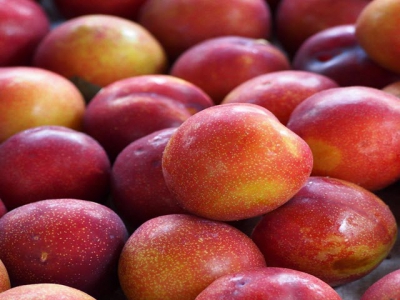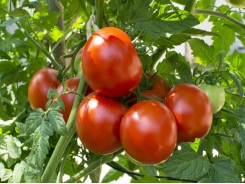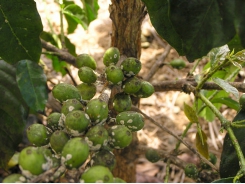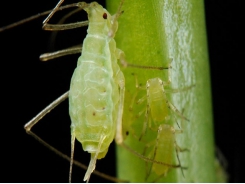Pests and Diseases of Tree Fruit - Part 1

Including: apples, pears, quinces, cherries, plums, damsons, peaches, almonds, apricots and nectarines
All tree fruit are susceptible to the following pests, diseases and common problems unless otherwise stated.
Aphids (various species)
Typical symptoms: Leaves and young shoots are infested with pink, green, black or brown aphids. Leaves may be distorted or tightly curled and sticky to the touch. Growth of young shoots may be reduced or distorted.
Prevention and treatment: See Aphids as Garden Pests
Apple canker (Nectria galligena)
This affects apples and pears (also hawthorn and poplar).
Typical symptoms: Twigs and branches show cracks around the base and wrinkled, discoloured, sunken patches. Spurs, shoots and branches may die.
Prevention and treatment: Grow varieties that are less-susceptible to this disease. Avoid poorly drained sites and overfeeding as both conditions will make trees more susceptible to canker. Inspect apple and pear trees regularly and cut out any canker immediately it is seen. Burn diseased wood and paint pruning cuts with Trichoderma paste.
Apple and other capsid bugs (Plesiocoris rugulipennis, Lygocoris pabulinus and others)
Apple, pear, plum and damson are susceptible to capsid bugs.
Typical symptoms: Tattered holes appear in young leaves; fruits are distorted and/or with raised bumps or scabs.
Prevention and treatment: Damage caused by capsid bugs is rarely severe. Little can be done other than to keep trees growing well.
Apple powdery mildew (Podosphaera Ieucotricha)
This affects apples and pears.
Typical symptoms: Powdery white coating on leaves, flowers and twigs.
Prevention and treatment: See How to Treat Common Plant Diseases
Apple sawfly (Hoplocampa testudinea)
Apple sawfly affects both apple and pear trees.
Typical symptoms: The damage caused by sawfly larvae is similar to that of the codling moth but occurs earlier in the season. A large cavity is eaten in the fruit; this cavity is filled with the droppings of the larvae, known as “frass”. The fruit may fall early. Fruit that does mature may show a characteristic ribbon scar.
Prevention and treatment: Remove and compost all fruits that fall early. If there is a regular severe problem, spray with derris liquid as directed on the container, usually at petal fall.
Apple scab (Venturia inaequalis); pear scab (Venturia pirina)
These affect apples and pears respectively.
Typical symptoms: Dark greenish-brown blotches on leaves and fruit. When infection is severe, leaves may fall early and fruit become cracked or corky. (Note that adverse soil conditions can also cause black blotches on pear leaves.)
Prevention and treatment: Grow resistant varieties, especially in wet areas. Do not grow susceptible plants in damp areas or close to water. Keep the tree open by pruning to allow good air flow. Collect up all fallen leaves in the autumn or run a mower over them to speed up decomposition. Prune out infected twigs, which will show blistered swellings. These measures will help reduce reinfection in spring.
Bacterial canker (Pseudomonas morsprunorum)
This affects plums, cherries and peaches.
Typical symptoms: Leaves have small round “shot” holes. Shallow depressions (cankers) appear on branches, often on one side of the branch only. If the canker girdles the branch, growth beyond it will die.
Prevention and treatment: Do not grow Victoria plum, which is particularly susceptible. Avoid wounding trees when staking and tying as the disease enters through wounds. Prune out and burn or dispose of diseased wood, cutting back into healthy wood as soon as it is noticed. Paint pruning cuts with Trichoderma paste. If the disease persists, spray with Bordeaux mixture in late summer and early and mid-autumn.
Bitter pit (calcium deficiency)
This affects apples, especially ‘Bramley’ and ‘Newton Wonder’. It is most frequent on young, vigorously growing trees.
Typical symptoms: The fruit becomes pitted and brown spots appear scattered through the flesh, which may also show “glassiness” — a translucency. These symptoms are caused by a shortage of calcium in the fruit, but this is rarely due to a calcium deficiency in the soil, rather an imbalance of calcium with other elements.
Prevention and treatment: Check the pH of the soil and add lime if it is much lower that 6.5. Do not overfeed with nitrogen or potash, both of which can reduce the availability of calcium. Maintain a regular supply of water to the tree by improving soil structure, mulching and watering when necessary. When bitter pit is a recurring problem, use the fruit as soon as it is ripe or preserve it by freezing or bottling. The condition develops further in stored apples.
Brown rot, blossom wilt, spur blight and wither tip (Sclerotinia fructigena; S. laxa)
This affects most tree fruit (also ornamental Prunus species).
Typical symptoms: Blossom wilts; fruit spurs may die after flowering; fruit develops soft brown patches with concentric rings of white pustules. Dehydrated fruit will hang on tree all winter.
Prevention and treatment: The fungus infects through wounds caused by weather, birds, insects and rubbing branches. Prune well, thin the fruit and try to repel birds. Remove all mummified fruit; prune out all infected wood, burn or dispose of it and treat the cuts with Trichoderma paste.
Bullfinches
Typical symptoms: Buds removed in winter; poorblossom and bare lengths of stem in spring.
Prevention and treatment: see Garden Pests and Diseases – Barriers and Traps
Codling moth (Cydia pomonella)
Apple and pear are susceptible to codling moth.
Typical symptoms: Codling moth caterpillars tunnel to the fruit’s core; it may be rendered inedible. The caterpillar usually leaves before the damage is discovered as there is generally no obvious sign of its presence on the outside of the fruit.
Prevention and treatment: Encourage bluetits into the garden as these are effective predators of the codling moth. To protect fruit, hang pheromone traps in the trees to catch male moths (see Garden Pests and Diseases – Barriers and Traps). The traps should be in place from late spring to late summer, or during early autumn in a dry year. However, traps alone may be sufficient to control coddling moths, in which case use them to indicate the presence of the moths so that spraying can be timed effectively: the young caterpillars must be killed before they can enter fruit. To ensure this, spray with derris seven to ten days after the moths are caught.
Coral spot (Nedria cinnabarina)
This affects all top fruit.
Typical symptoms: Masses of bright pink pustules appear on dead wood. Branches may die back.
Prevention and treatment: See How to Treat Common Plant Diseases
Fireblight (Erwinia amylovora)
This affects apple and pear trees (also other related ornamentals).
Typical symptoms: Dead blossoms and dark brown leaves hang from affected branches giving the appearance of having been scorched by fire. A mature tree can be killed in as little as six months.
Prevention and treatment: Pear varieties that flower in summer are much more prone to infection than those that flower early. Prune out infected branches immediately, cutting at least 45cm (1-1/2ft) into the healthy wood. If this procedure does not save the plant, dig it out and burn or dispose of it.
Honey fungus (Armillaria mellea)
This affects all top fruit.
Typical symptoms: Trees die suddenly. The bark near the base of the trunk pulls away easily, revealing a white sheet of fungal growth of mushrooms.
Prevention and treatment: See How to Treat Common Plant Diseases
Related news
Tools

Phối trộn thức ăn chăn nuôi

Pha dung dịch thủy canh

Định mức cho tôm ăn

Phối trộn phân bón NPK

Xác định tỷ lệ tôm sống

Chuyển đổi đơn vị phân bón

Xác định công suất sục khí

Chuyển đổi đơn vị tôm

Tính diện tích nhà kính

Tính thể tích ao




 Growing Lettuce in Greenhouses and Frames
Growing Lettuce in Greenhouses and Frames  Biological Control of Common Greenhouse Pests - Part…
Biological Control of Common Greenhouse Pests - Part…